A new OLED display from Samsung and Stanford can achieve more than 10,000 pixels per inch, which might lead to advanced virtual reality and augmented reality displays, researchers say.
An organic light-emitting diode (OLED) display possesses a film of organic compounds that emits light in response to an electric current. A commercial large-scale OLED television might have a pixel density of about 100 to 200 pixels per inch (PPI), whereas a mobile phone's OLED display might achieve 400 to 500 PPI.
Two different kinds of OLED displays have reached commercial success in mobile devices and large-scale TVs. Mobile devices mostly used red, green and blue OLEDs, which companies manufacture by depositing dots of organic film through metal sheets with many tiny holes punched in them. However, the thickness of these metal sheets limits how small these fabricated dots can be and sagging of these metal sheets limits how large these displays can get.
In contrast, large-scale TVs use white OLEDs with color filters placed over them. However, these filters absorb more than 70% of light from the OLEDs. As such, these displays are power-hungry and can suffer "burn-in" of images that linger too long. The filters also limit how much the pixels can scale down in size.
The new display uses OLED films to emit white light between two reflective layers, one of which is made of a silver film, whereas the other is a "metasurface," or forest of microscopic pillars each spaced less than a wavelength of light apart. Square clusters of these 80-nanometer-high, 100-nanometer-wide silver pillars served as pixels each roughly 2.4 microns wide, or slightly less than 1/10,000th of an inch.
Each pixel in the new display's metasurface is divided into four subpixels of equal size. In principle, the OLED films can specify which subpixels they illuminate. The nano-pillars in each subpixel manipulate white light falling onto them, such that each subpixel can reflect a specific color of light, depending on the amount of spacing between its nano-pillars. In each pixel, the subpixel with the most densely packed nano-pillars yields red light; the one with moderately densely packed nano-pillars yields green light; and the two with the least densely packed nano-pillars yield blue light.

Emitted light reflects back and forth between the display's reflective layers until it finally escapes through the silver film out the display's surface. The way in which light can build up within the display gives it twice the luminescence efficiency of standard color-filtered white OLED displays, as well as higher color purity, the researchers say.
"If you think of a musical instrument, you often see an acoustic cavity that sounds come out of that helps make a nice and beautiful pure tone," says study senior author Mark Brongersma, an optical engineer at Stanford University. "The same happens here with light — the different colors of light can resonate in these pixels."
In the near term, one potential application for this new display is with virtual reality (VR). Since VR headsets place their displays close to a user's eyes, high-resolutions are key to help create the illusion of reality, Brongersma says.
As impressive as 10,000 pixels per inch might sound, "according to our simulation results, the theoretical scaling limit of pixel density is estimated to be 20,000 pixels per inch," says study lead author Won-Jae Joo, a nanophotonic engineer at the Samsung Advanced Institute of Technology in Suwon, Korea. "The challenge is the trade-off in brightness when the pixel dimensions go below one micrometer."
Other research groups have developed displays they say range from 10,000 to 30,000 pixels per inch, typically using micro-LED technology, such as Jade Bird Display in China and VueReal in Canada. In terms of how the new OLED display compares with those others, "our color purity is very high," Brongersma says.
In the future, metasurfaces might also find use trapping light in applications such as solar cells and light sensors, Brongersma says.
The scientists detailed their findings online Oct. 22 in the journal Science.
Charles Q. Choi is a science reporter who contributes regularly to IEEE Spectrum. He has written for Scientific American, The New York Times, Wired, and Science, among others.



